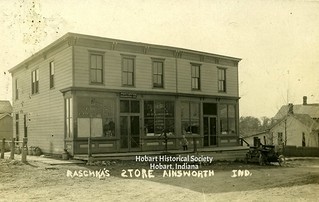
(Click on image to enlarge)
William and Carrie Raschka's store on the southwest corner of Ainsworth Road and State Road 51, circa 1905-10. Image courtesy of the Hobart Historical Society.
In September 1901, when the Hobart Gazette reported that Willard O. Halsted had traded his Ainsworth store to Grant Hardesty for 160 acres of farmland, it said that Willard had "been conducting a general store at Ainsworth for twelve or fifteen years." Twelve years was probably the more accurate figure, as another source tells us that the Halsteds came to Ainsworth "soon after" the birth of their son in September 1888. Thus the original part of this store — if Willard built it as his first store — may date to 1888 or 1889.
Either the deal with Grant Hardesty was rescinded or the Gazette was mistaken about its ever happening, because in January 1902 Willard sold his store, "realty and all," to William Raschka. I've already given some background on William and Carrie Raschka and family.
The store's inventory was described as "general merchandise" at the time of the sale, and I believe that same description applied while William and Carrie operated the store. In the photo above, the window-lettering advertises "groceries" and "dry goods." Now and then William would advertise some special item in the Gazette, e.g., binder twine (7 or 9 cents a pound), seed potatoes (75 cents a bushel) and eating potatoes (55 cents a bushel), "bailed" Timothy hay ($12 a ton), dry 4-foot wood (price not specified), and even decoy ducks ($1 a pair). He also sold coal and feed for livestock.
The store did a lively business and William required the help. Early on, a teenage girl from the neighborhood, Jennie Pierce, clerked for him. Carrie also worked in the store, as did William's brother Frank.
The store was the base of operations for William's shipping enterprises. He contracted with various farmers in the area (including John Chester) to sell their hay, and he shipped out carloads of baled hay from the Ainsworth depot. In late 1904, he reported shipping out dozens of crates of poultry.
Also in 1904, William was appointed postmaster, to replace Hugh Dotzer. The store became Ainsworth's post office, and William served for the next 11 years.
Business was good enough to justify expansion. By October 1905, the Raschkas had built a two-story, 20-by-50-foot addition to the store. (I think the right-hand side of the building in the photo may be that addition, and that line down the front of the building marks off the old from the new.)
William and Carrie bought a car, and they added another building to their lot, for storage and for a "garage room." That was in 1910, and there we end the story of the store — for now; there are many more years to come in its life.
Sources:
♦ "Ainsworth News." Hobart Gazette 24 Jan. 1902; 17 Apr. 1903.
♦ "Ainsworth Pick-Ups." Hobart Gazette 11 Nov. 1904; 24 Nov. 1904; 16 Dec. 1904; 23 Dec. 1904; 30 Dec. 1904; 16 Jan. 1905; 24 June 1910; 29 July 1910; 26 Aug. 1910; 2 Sept. 1910.
♦ Ballantyne, Dorothy, and Robert Adams. Along the Route: A History of Hobart, Indiana, Post Offices and Postmasters. Hobart: The Hobart Historical Society, Inc., 1992.
♦ "Binder Twine For Sale." Hobart Gazette 29 June 1906.
♦ "General News Items." Hobart Gazette 27 Sept. 1901; 17 Jan. 1902; 10 June 1904; 22 Sept. 1905; 1 Feb. 1907; 25 Oct. 1907; 3 Jan. 1908; 14 Feb. 1908.
♦ "Local Drifts." Hobart Gazette 17 Jan. 1902; 24 Jan. 1902; 30 Oct. 1908; 7 July 1909.
♦ "Young Man Passes Away." Hobart Gazette 11 Mar. 1910.


No comments:
Post a Comment